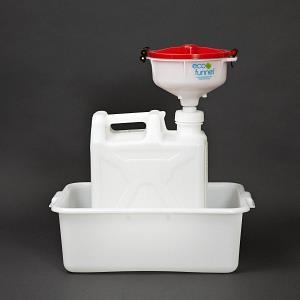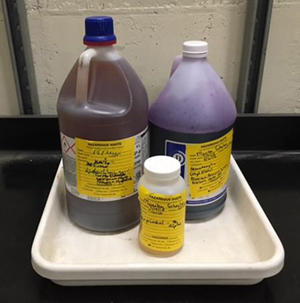Most hazardous waste containers generated at the UMN are stored in satellite accumulation areas (SAA). SAAs are used to manage hazardous waste in laboratories and other areas because doing so provides a safe and effective means to accumulate hazardous waste before removal by HSRM. Additionally, SAAs provide the least restrictive regulatory option for the accumulation and storage of hazardous waste containers. While identification of SAAs by signage is not required, it is recommended as a good practice. The Hazardous Waste Storage Fact Sheet can be posted in waste storage areas. The following SAA rules must be followed at all times when managing hazardous waste:
- All waste must be stored in containers that are suitable for the type of waste they contain. Usually the original container of the main component of the waste can be used (e.g., 4-liter glass jar). Reusable containers such as a 20-liter carboy can also be used to collect waste. More detail regarding chemical waste containers can be found in Section 8.3.4 of this document.
- Containers must remain closed at all times except when adding or removing waste. Open waste containers are the most common EPA hazardous waste violations cited at colleges and universities. Safety funnels that close and seal can be used as a more convenient way to fill waste containers as shown in Figure 8.1.
- Containers must be properly labeled. The following elements must be on container label: the words “Hazardous Waste”, an accurate description of the waste, a description of the primary hazard present, and the date waste was first added to the container (start date). More detail regarding hazardous waste container labeling can be found in Section 8.3.3.
- All containers must be in good condition and not leaking. Containers must be relatively clean without gross chemical contamination on the outside of the container. If a container holding hazardous waste is not in good condition, or if it begins to leak, the waste should be transferred to a container that is in good condition. Alternatively, over-pack the container that is leaking or in poor condition into a larger, compatible container with a tight fitting lid as illustrated in Figure 8.2.
- All liquid waste must be stored in secondary containment. Trays, tubs, or buckets are all acceptable forms of secondary containment as shown in Figure 8.3
- Containers must be stored at or near the point of generation and under the control of the generator of the waste. Waste must remain in the same room that it is generated in. Establish an area to accumulate hazardous waste. This area can be a bench top, fume hood that is being used for storage, or a cabinet. Store containers upright and securely. Do not place containers in areas such as hallways, doorways, sinks, or next to moving equipment where the chance of spills is likely.
- The waste storage volume should never exceed 55 gallons per SAA. Submit waste to HSRM on a routine basis to avoid excess storage.
- Containers must be segregated by chemical compatibility during storage. For example, acids (e.g., hydrochloric acid) must be stored away from bases (e.g., sodium hydroxide) and organic acids (e.g., acetic acid) must be stored away from oxidizing acids (e.g., nitric acid). Segregation can be achieved either by physical distance or by secondary containment.
- Do not put incompatible chemicals in the same waste container. Generally, only wastes with the same hazard class should be added to a waste container. More detail regarding waste collection containers can be found in Section 8.3.4.


